The London region covers most of the urban sprawl of the British capital. The Greater London region covers all 33 London boroughs, and is governed by a devolved Greater London Assembly led by the Conservative Party’s Mayor of London, Boris Johnson.
In 2005, Labour won 44 of London’s seats, the Conservatives won 21, the Liberal Democrats won eight, and one seat was won by the left-wing Respect Coalition’s George Galloway, who had previously been a left-wing Labour MP representing a seat in Glasgow before his expulsion from Labour in 2003.
The most recent redistribution saw London lose one of its seats. Calculations indicate that Labour and the Conservatives, along with Galloway, have maintained all of their seats. The Liberal Democrats have lost one of their eight seats, Brent East, which is the sole Liberal Democrat seat in London’s North East and has been held by Sarah Teather since a 2003 by-election. Brent East and Brent South have been merged into Brent Central, creating a Labour/LibDem contest.
Most Conservative seats in London lie around the fringe of the region, particularly along the northern border and in the south-east corner of the seat. There is also a string of five seats from Wimbledon and Putney in the southwest to three seats around Chelsea, Kensington and Westminster in the centre of London.
Five Liberal Democrats seats lie in a group on the southwestern edge of London. They also hold one seat, Bermondsey & Old Southwark, on the southern shore of the Thames in central London and Hornsey & Wood Green in the north of London.
Galloway’s seat of Bethnal Green & Bow lies in the inner northeast of London, and the Labour Party holds seats throughout the city.
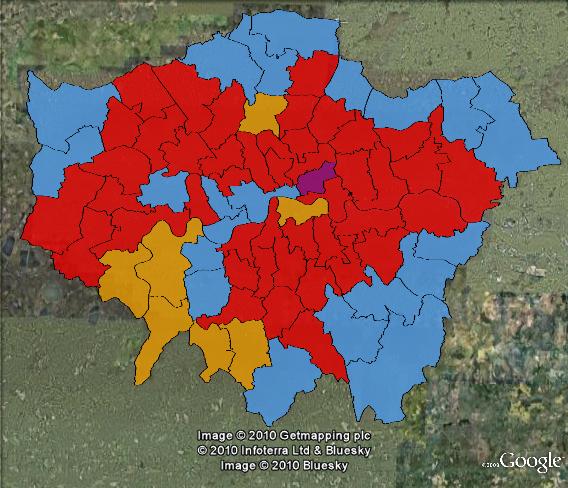
Recent history
- 1987 – 57 CON, 23 LAB, 2 SDP, 1 LIB
- 1992 – 47 CON, 35 LAB, 1 LD
- 1997 – 57 LAB, 11 CON, 6 LD
- 2001 – 55 LAB, 13 CON, 6 LD
- 2005 – 44 LAB, 21 CON, 8 LD, 1 Respect
At the 1987 election the Conservatives dominated London, with 57 seats, with 23 going to Labour and three seats going to the SDP-Liberal alliance, with the Liberals holding on to Southwark & Bermondsey and the Social Democratic Party winning Greenwich and Woolwich.
In 1992 Labour gained twelve seats. They won ten off the Conservatives and won both the former SDP seats off the Liberal Democrats, who held on to a single seat, Simon Hughes’ Southwark & Bermondsey.
In 1997, a redistribution cut London’s seats from 83 to 74, and Labour took a large number of seats from the Conservatives, who fell from 47 seats to only 11, while the Labour Party won 57. The Liberal Democrats, in a strong national result, won five extra seats along the southwestern edge of London, bringing their total to six.
The 2001 election saw the Labour Party lose two seats to the Conservatives in the northeastern corner of London, while the Liberal Democrats maintained their six seats, although they gained a seventh in Brent East in a 2003 by-election.
The Labour Party lost a further ten seats in 2005, as well as failing to regain Brent East. They lost eight seats to the Conservatives, and Hornsey & Wood Green was lost to the Liberal Democrats in northern London. In a dramatic result, former rebel Labour MP George Galloway won the seat of Bethnal Green & Bow off pro-war Labour MP Oona King, supported by the anti-war Respect Coalition.
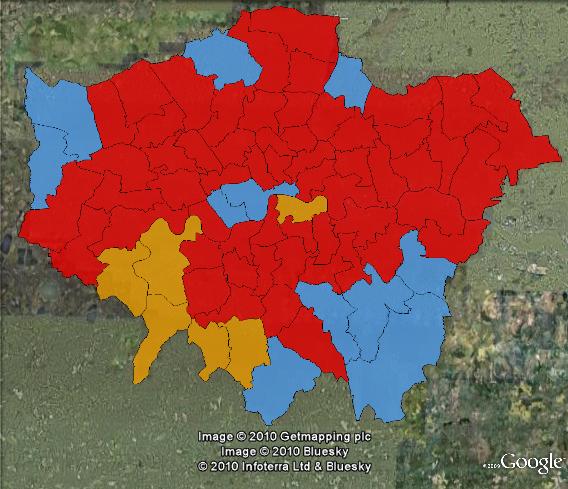
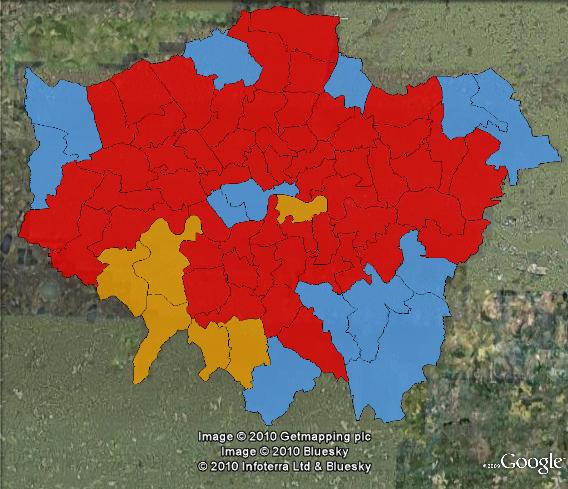
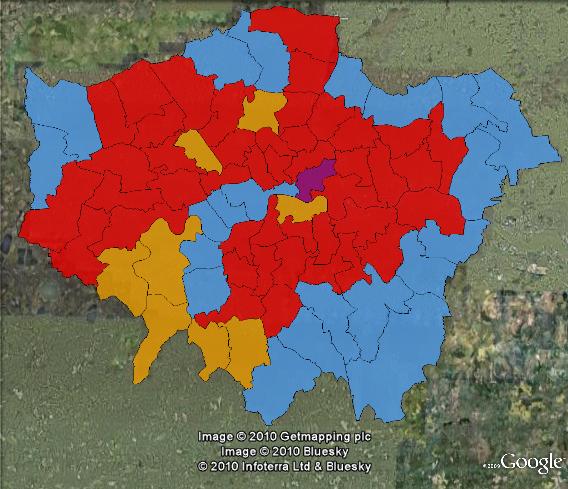
The key seats
- Bethnal Green & Bow – Held by Respect’s George Galloway, he is stepping down to stand in nearby Poplar & Limehouse. Respect are standing Abjol Miah, leader of Respect’s team on Tower Hamlets council. The seat is 32nd on Labour’s target list, and could be one of their few gains across the country.
- Poplar & Limehouse – Following the redistribution, Labour holds this seat with an 11.5% margin over the Conservatives, closely followed by Respect. Sitting MP Jim Fitzpatrick, a junior minister since 2005, is being challenged by Respect MP George Galloway. This seat is also 105th on the Conservative target list, so could produce an interesting three-way contest with Labour being challenged from both left and right.
- Finchley & Golders Green, Crawley, Croydon Central and Battersea – these four seats are the first four seats on the Conservative target list. If there is any swing to the Conservatives, these seats should easily fall.
- Carshalton & Wallington, Richmond Park and Sutton & Cheam – These three Liberal Democrat seats are held by margins of less than 4% over the Conservatives, and could be vulnerable if there is a swing away from the LibDems to the Conservatives.
- Ealing Central & Acton – This seat is third on the Labour target list and ninth on the Lib Dem target list, making it a genuine three-cornered contest. The seat was won by Labour in 2005 but on UK Polling Report figures it is now a notionally Conservative seat.
- Hampstead & Kilburn – This seat is also a three-cornered contest. While the Conservatives outpolled the Lib Dems in 2005, the redistribution has pushed the Lib Dems within 3% of the Labour Party while pushing the Conservatives back to 10% behind the Lib Dems. You’d expect that the Lib Dems would have a strong chance of winning, but a large swing to the Conservatives could see them leapfrog into first place.
- Islington South & Finsbury – The Labour Party holds this seat by a slim margin over the Liberal Democrats, with Bridget Fox coming within 1.6% of winning the seat in 2005. The seat is a strong prospect for the Lib Dems to pick up in 2010 if Labour is losing support and the Liberal Democrats are maintaining their support.
- Brentford & Isleworth, Hammersmith, Hendon, Westminster North – these four seats are all held by Labour and targeted by the Conservatives. With margins in the 4-7% range, winning these seats would indicate that the Conservatives are on track to be the largest party in the Commons.
- Barking – This North-East London seat saw the British National Party poll their highest in the UK in 2005, with 17%. While the boundaries have notionally reduced the BNP vote, the new areas have shown willingness to elect BNP councillors. The BNP are standing their leader Nick Griffin, who was elected to the European Parliament for North-West England in 2009. The BNP should have a strong chance of overtaking the Conservatives, but a Labour vote of over 47% should be enough to withstand the BNP assault.
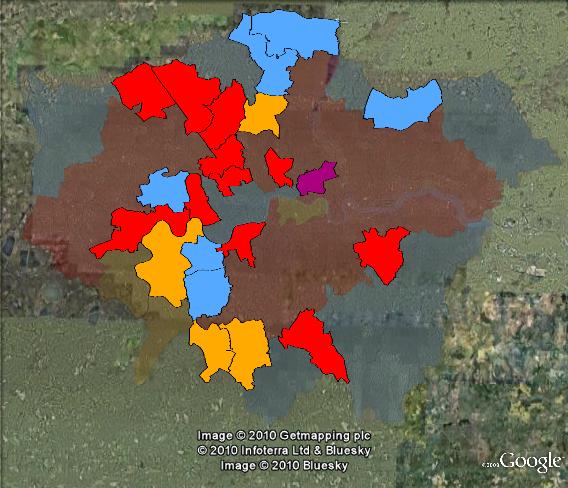
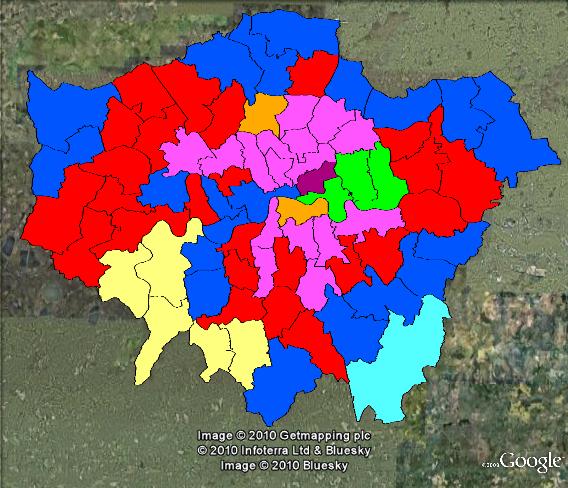
Elsewhere: The Guardian‘s profile of the race in London, and UK Polling Report’s profiles on London’s seats.


Cool maps.
George Galloway’s 2005 victory speech is quite memorable. Whilst other candidates start by thanking the returning officer, he instead started by telling the returning officer that he should ‘resign in disgrace’ for allegedly ‘presiding over a sham election that would befit a banana republic’. He then announced that the campaign to take control of Tower Hamlets council, so that the returning officer could be sacked, would commence the following week!
No comment on Barking where BNP leader Nick Griffin is taking on Labour? He won’t win, needless to say, but it is an interesting seat to watch.
Thanks Gael, I hadn’t realised Griffin’s seat was in London, I thought he was running somewhere in the northwest where he holds the MEP seat.
There are 3 Labour seats further up the Conservative target list where the Tories are favourites with the bookies: Eltham, Harrow East and Tooting.
Also worth watching will be Brent Central, where Sarah Teather, Lib Dem MP from the abolished Brent East, is trying to overturn a large Labour majority. Labour would ha expected to hold on, but Teather has defied expectations twice before.
My prediction: CON 32, LAB 30, LD 11.